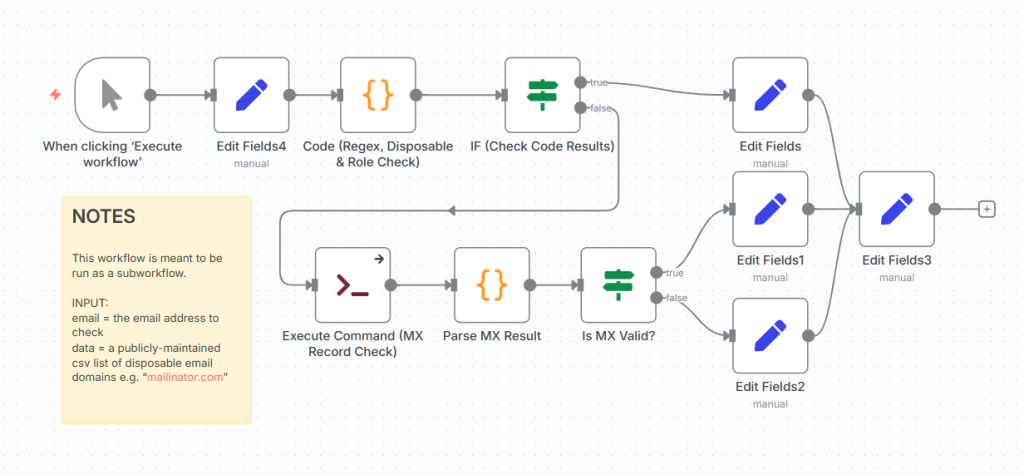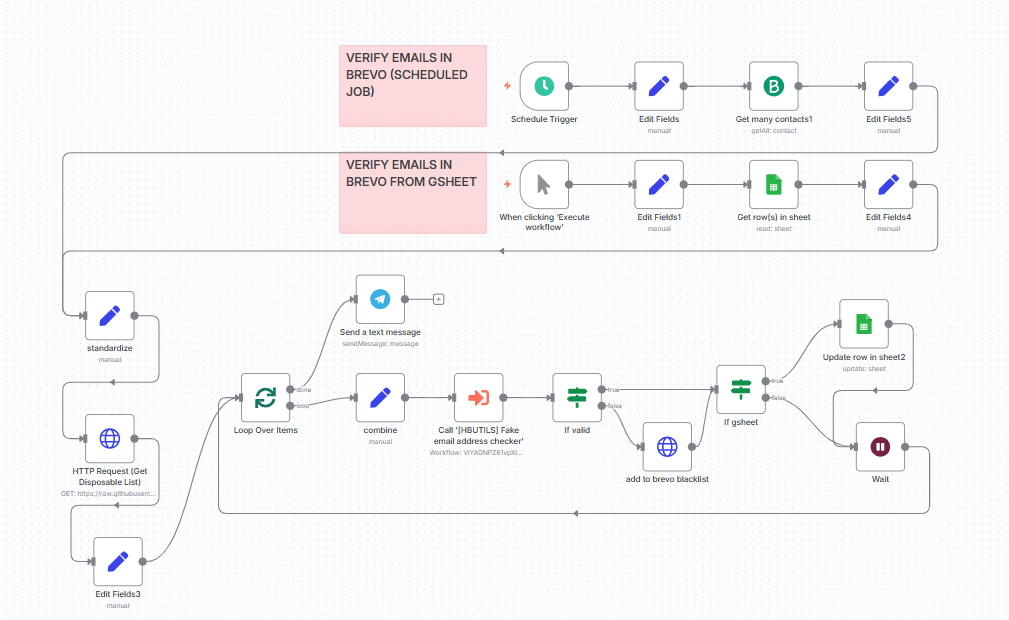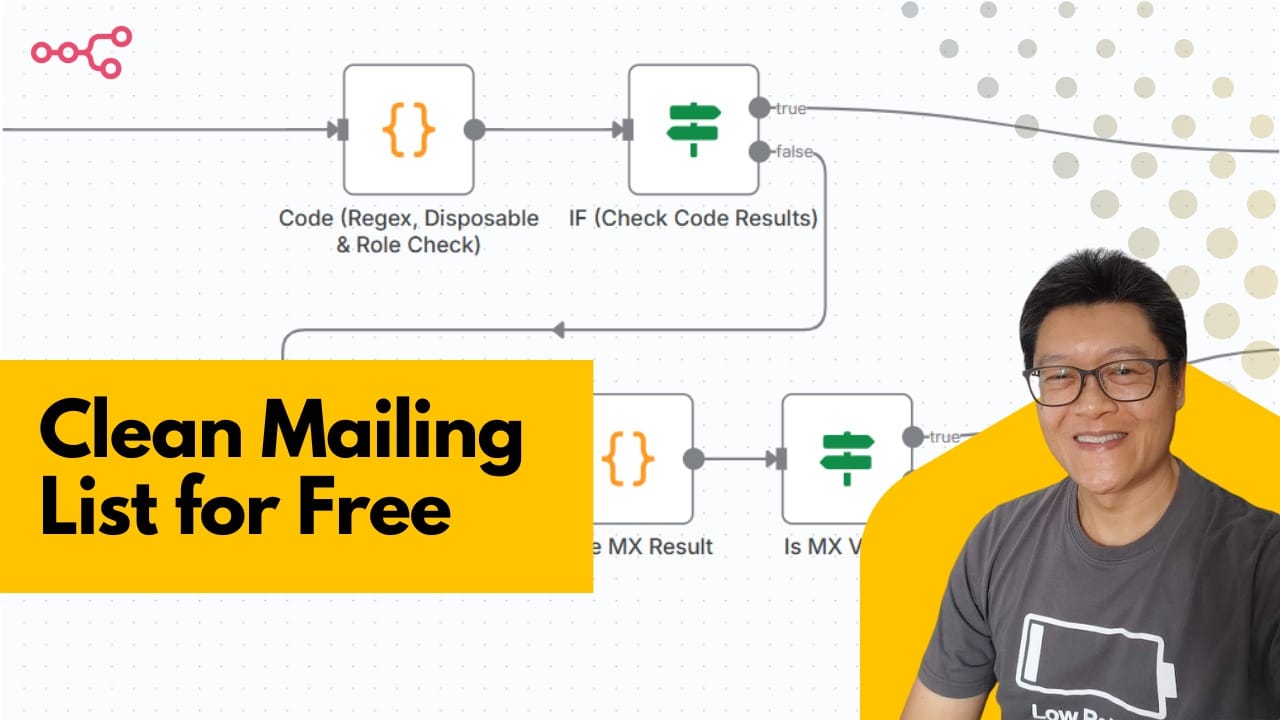One time, I deployed a WooCommerce store but didn’t secure the sign up page with recaptcha. Weeks later, the store got hit with thousands of fake user sign ups. And since I hooked up the store to a mailing list on Brevo, I was suddenly sending my newsletter to 4000 fake emails.
If bots and throwaway emails are wasting your email budget and hurting deliverability, here’s a free, automated email verification workflow in n8n that checks for disposable domains, bot patterns, and typo emails.
Fake emails will hurt your email campaigns (and your sender reputation)
If you send an email newsletter to a spammy mailing list, your metrics will be terrible. The costs are high because the list is bigger. But the bounce rates will be high too. And yet, the open rates will be super low.
This is also bad because lots of bounces causes your sender reputation to drop. So any emails from you will end up in your customer’s spam boxes instead of the inbox.
Worse still, a huge spike in bounces can cause your email service provider to shut you down.
The Costs of a Dirty Email List
Having a dirty email list is like having a leaky bucket for your business. You think you’re collecting water, but most of it is just draining away. And worse, it’s costing you money and time.
Financial
Most email service providers (ESPs) like Mailchimp charge you based on the number of contacts you have (btw, Brevo charges by email recipients instead of overall number of contacts)
So, if you have thousands of fake emails on your list, you are literally paying to send emails to no one. Even if it costs less than a cent per contact per month, that quickly adds up.
Reputation
Your sender reputation is everything when it comes to email marketing. Bounces and spam reports are red flags to inbox providers. They signal that you might be a risky sender. And when that happens, your emails start landing in the spam folder more often.
Gmail and Yahoo’s bulk sender rules are really strict. They punish high bounce rates and spam complaints, making it harder for legitimate emails to land in the inbox.
Once your reputation takes a hit, it’s a very slow climb back. You want your messages to reach inboxes, not get lost.
Performance and compliance
A dirty list also completely messes up your performance metrics. If you’re testing different email subject lines or content, skewed data means you can’t trust your results.
It makes optimisation a nightmare. You might think a campaign is doing well, but actually, it’s only reaching a fraction of your real audience.
Apple’s Mail Privacy Protection (MPP) also blurs open data. So, if your list is dirty, it’s even harder to tell what’s going on with your engagement. This makes accurate campaign analysis a headache.
There’s also the risk of sending emails to ‘role accounts’ like info@ or sales@, or even strangers. This can easily lead to more complaints, which further damages your reputation.
Cleaning Methods
The old-school method is manual cleaning. This means you export your entire email list as a CSV file. Then, you scan through hundreds or thousands of email addresses, looking for dodgy domains or fixing typos by hand.
It’s incredibly slow and you can make many mistakes. And, honestly, it’s just not possible to do this properly when your list is big.
Another option is to use third-party email cleaning services. You send them your list, and they process it for you. These include services like neverbounce and omnisend.
The thing is, you usually have to pay to process 100 percent of your list, even if only 10 percent of it is bad. It’s like paying for a full car wash when only the front bumper is dirty.
The cost-effective way: your own n8n workflow

Another way to maintain a clean list is to build your own email verification workflow using n8n.
This is a one-time setup that then runs on autopilot. Once you’ve set it up, you can basically forget about it.
And it can be completely free if you self-host n8n using Docker or on a small VPS. You get all the power without the recurring costs.
With your own n8n workflow, you get full control. You decide on the rules, the thresholds for flagging emails, and what actions to take.
How It Works: A 5‑Point Email Verification Check
I’ve built this workflow around five key verification points, plus some extra helpful ones.
Check 1: Proper formatting
The first step is a basic sanity check. This check rejects any email addresses with invalid characters or bad structures, such as alex@gmail,com (with a comma).
Check 2: Disposable domains
Next, we tackle disposable domains. These are those temporary email addresses that people use once and then throw away.
They are often used for signing up to things without genuine interest.
Our workflow compares incoming emails against a big list of over 4,700 known disposable email providers. You can get the list from this public GitHub source.
Check 3: Spammy bot patterns
Bots often have predictable ways of creating email addresses. We look for these spammy bot patterns.
For example, we flag Gmail local parts that have too many dots or repeated characters. These patterns look like “[email protected]”
Check 4: Excessive numbers
Too many numbers in the local part of an email can be a big red flag for a bot. This check counts the digits. If it goes above a threshold you set, say 8 numbers, it gets flagged.
Check 5: Domain existence and common typos
It’s important to make sure the domain actually exists. Our workflow does an nslookup check for this. It’s like making sure the house actually has a street address. This will catch common typos like `gmial.com`, `hotmai.com`, or `outlok.com`. And it also catches fakes like [email protected]
Check 6: Extras
Besides the core five, we added some useful optional checks you can add to make your list even cleaner. These can be configured as needed.
You can flag out role accounts like `info@`, `sales@`, or `admin@`, which hardly ever get responses. Or, you can flag out emails with plus addressing, such as ‘[email protected]’.
Limitations
This workflow is great to weed out a large percentage of fakes. However, paid services like neverbounce do a lot more when checking an email address. These services will perform real-time mailbox existence verification via an SMTP check. That means, they will check if there really is an inbox at that email address.
If you are using an email sending platform like Brevo, then any emails that get a hard bounce (for example, user mailbox does not exist), will be automatically unsubscribed anyway. So, my workflow is a good first line of defence to keep mailing lists from getting bloated by fakes.
Full Automation: Set It and Forget It

The real efficiency happens when you set this workflow to run on autopilot. In n8n, you can schedule it to run weekly or daily. This means your n8n workflow will automatically fetch and clean your list at a time that suits you, like clockwork.
And instead of cleaning a list from a Google Sheet, you can hook it up to get the latest sign ups from your mailing list provider, validate it, and unsubscribe the ones the invalid ones. All happening regularly in the background.
Good email setup is still important
There’s no guarantee that your emails will land in the inbox every single time. Deliverability is complex, and many other things affect it. You still need to set up SPF, DKIM, and DMARC for your domain, and your content needs to be healthy and relevant. You also need engaged audiences who actually want to hear from you.
But by using this workflow to clean up fake sign ups, you’re already starting from a good spot.
Download my email verification n8n template and let me know what you think!
Watch Video: Improve Email Open Rates With n8n



Leave a Reply